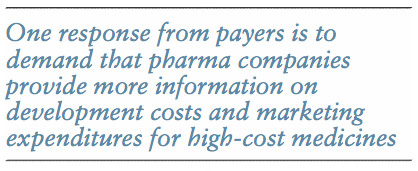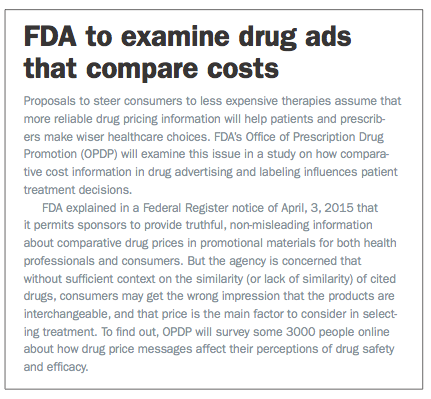Cost & Coverage Challenges for Pharma
Pharmaceutical Executive
Insurers and payers demand lower prices-along with quality and innovation.
Jill Wechsler

Rampant concerns about the affordability of, and access to, new life-saving therapies is widening the Great Debate over how much society should pay for new biomedical discoveries. Insurers, pharmacy benefit managers (PBMs), and public and private payers continue to challenge pharma prices, heightened by concerns about covering more new medicines to treat widespread conditions such as high cholesterol and diabetes.
The result is closer scrutiny of product value, pressures to boost discounts and rebates, and support for less costly biosimilars to spur market competition. A sign of the times is a move by prominent hedge-fund operator Kyle Bass to launch a fund that will gain from his challenges of drug company patents that Bass believes are spurious and designed to jack up drug prices. National Institutes of Health researchers recently published an article in the Journal of the American Medical Association Oncology (April 2, 2015) documenting that many new, costly cancer therapies fail to extend survival. Medical breakthroughs in the war on cancer continue to make headlines, as seen in the recent PBS special report on cancer. While highlighting exciting scientific discoveries that could transform this “emperor of all maladies” into a manageable condition, it discussed fears that high prices could limit access to innovative therapies.
More transparency
One response from payers is to demand that pharma companies provide more information on development costs and marketing expenditures for high-cost medicines. Oregon legislators recently followed California’s lead in proposing legislation requiring manufacturers to file annual cost reports for medicines with wholesale acquisition costs of $10,000 or more a year. The reports would disclose R&D outlays (including acquisition, licensing, and clinical trial costs), marketing expenditures, total profits attributed to the drug, and financial assistance provided to patients. Pharma and biotech companies protested that such proposals ultimately would block sales of covered products in the state, due to the risk of revealing proprietary information, particularly for small, privately held firms.
Insurers also look to gain leverage in negotiating discounts with pharma companies by becoming bigger players in the PBM business. UnitedHealth recently paid $13 billion for Catamaran, which, when combined with its existing OptumRx, will compete more directly with field leaders Express Scripts and CVS Caremark in a more consolidated field.

More transparency in European drug pricing could result from increased collaboration among the national health programs of 27 European nations, according to a March report on “Access to New Medicines in Europe” from the World Health Organization (WHO). Agency analysts urge European authorities to share information on drug cost-effectiveness and to adopt off-label drug uses that save money, such as treatments for age-related macular degeneration. While the report applauded the development of more new therapies, it seeks to ensure that patients “are not provided with expensive new medicines that offer little or no improvement in health outcomes.” And where market approval is based on limited preliminary data, WHO advises regulators to utilize adaptive licensing or conditional approval strategies to limit patient exposure pending confirmation of product safety and efficacy.
Medicare strategies
At home, Medicare is looking to update drug payment and coverage policies to gain more control over outlays for prescription drugs that look to increase significantly. The Centers for Medicare and Medicaid Services (CMS) is encouraging physicians to prescribe new biosimilars headed for market, as seen in its recent statement clarifying that providers will be reimbursed equally for administering a biosimilar therapy under Medicare Part B, as for the innovator product. CMS also issued a unique Q code for Sandoz’ recently approved Zarxio (instead of waiting a year) to encourage provider uptake.
New CMS guidance also encourages sponsors of Part D drug plans to add a new biosimilar to formularies by noting that such changes can be made at any time. Adding the biosimilar to the reference product on the formulary, though, won’t meet the two-drugs-per-class requirement, but that should boost a plan’s leverage in negotiating better rates since either the brand and/or the biosimilar could be excluded from formulary altogether, explains Amada Bartelme of Avalere Health.
Meanwhile, the Medicare Payment Advisory Commission (MedPAC) continues to examine a range of strategies for managing program spending on pharmaceuticals. Its analysts are examining better ways to address “polypharmacy,” particularly for elderly patients on pain medications, to evaluate how bundling of Part B oncology services may encourage appropriate use of oncology drugs, and to weigh alternatives for how Part D plans assume risk for high-cost beneficiaries.

Limiting patient costs
A main response from pharma marketers and some patient advocates is to promote strategies to minimize out-of-pocket (OOP) drug costs for patients. They support bipartisan legislation that requires insurers to charge individuals fixed copayments instead of the 25%-30% cost-sharing on high-tier specialty medicines, which translates into OOP payments of $25,000 on new therapies priced at $100,000 a year or more.
A related tactic is to shift important medicines out of high-cost formulary tiers and to reduce prior authorization and quantity limits that make certain drugs hard to obtain. The AIDS patient community has charged plans that place HIV medicines in high-cost categories with discrimination against HIV-AIDS patients. That prompted Aetna to announce a few weeks ago that it would move most HIV drugs in its CoventryOne operation in Florida from specialty to generic or non-preferred tiers. “Adverse tiering” of drugs for high-cost conditions, such as cancer, diabetes, rheumatoid arthritis, as well as AIDS, may violate anti-discrimination standards for qualified health plans under the Affordable Care Act.
Meanwhile, federal and state prosecutors are keeping a close watch on pharma pricing and discounting strategies to uncover evidence of kickbacks or fraud. In February, AstraZeneca agreed to pay an $8 million penalty to settle charges with the Justice Department involving discounts to a PBM to gain exclusive formulary placement for its Nexium heartburn pill. The feds challenged such “hidden financial agreements” and affirmed its continued interest in formulary placement deals. Errors in reporting drug pricing data to Medicare also has led to fines and legal action, as seen in Novartis’ agreement in March to pay a $12.6 million fine to settle charges that its Sandoz unit submitted faulty data to Medicare Part B.
Jill Wechsler is Pharmaceutical Executive's Washington correspondent. She can be reached at jwechsler@advanstar.com
Have your say: leave a comment below

Navigating Distrust: Pharma in the Age of Social Media
February 18th 2025Ian Baer, Founder and CEO of Sooth, discusses how the growing distrust in social media will impact industry marketing strategies and the relationships between pharmaceutical companies and the patients they aim to serve. He also explains dark social, how to combat misinformation, closing the trust gap, and more.